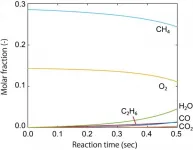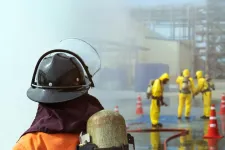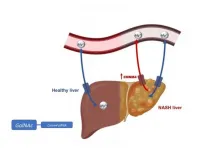(Press-News.org) The human genome contains roughly three million letters. On average, the genome sequences of any two people differ from each other by about one in every 1,000 letters. Yet different variants occur, from substituted letters to entire missing sections of DNA. Scientists from the Berlin Institute of Health (BIH) and the Regensburg Center for Interventional Immunology (RCI) have teamed up with Icelandic researchers to develop software that reliably and quickly identifies large deletions in ten-thousands of genomes simultaneously. The researchers have now published their findings in the journal Nature Communications.
The human genome contains roughly three million letters and is distributed over 46 chromosomes. Yet the genetic variation from person to person is very small: the genome sequences of any two people differ from each other by about one in every 1,000 letters. Sometimes single letters are exchanged in the genome, while other times whole sections are moved around. "Many of these differences go unnoticed, because they do not affect the structure of the proteins encoded in the genome and do not cause any diseases," says Birte Kehr, a junior group leader at the Berlin Institute of Health (BIH) who was recently appointed professor at the Regensburg Center for Interventional Immunology (RCI). The bioinformatician is working on so-called structural variants, in which larger segments of the genome are deleted, duplicated or even swapped between chromosomes.
Large structural changes have a big impact
"Large structural changes are much rarer than changes in single letters," Kehr explains, "but they often have a bigger impact and are also harder to detect." To learn more about these bigger changes, it is helpful to use large databases to search for them. That's where the collaboration with the Icelandic company deCODE Genetics came in, whose database contains some 50,000 human genome sequences and where Kehr formerly worked as a postdoc. "We always planned to search for deletions in the data, but we didn't have a program capable of reliably and quickly processing such huge amounts of data." When Kehr joined the BIH in Berlin, she gave this task to her first Ph.D. student, Sebastian Niehus.
Data is valuable only if it is used
The programs previously available for identifying structural variants such as deletions could only process data from a few individuals at a time. For large data sets, such as those in the deCODE genome database, the results then had to be combined, which was a cumbersome and error-prone process. "We first wanted to develop a statistical model that would enable us to evaluate information from all genomes simultaneously," Niehus reports. "To do this, the program had to be designed so that a computer could quickly sift through huge quantities of data. We also had to compress the files to 1 to 2 percent of their original size to be able to work with them at all."
Faster and more accurate than other software
Once a prototype was developed, the PopDel program had to prove itself against other programs in various scenarios. These included simulated sequence data from up to 1,000 "individuals"; sequence data from 49 parent-child trios, which allowed a thorough analysis of whether inheritance patterns were reconstructed correctly; sequence data from 150 individuals of different ethnicities, which made it possible to evaluate population structures; and finally the approximately 50,000 genomes from the Icelandic cooperation partner deCODE Genetics.
"We were able to show that PopDel produced good results in a quick, reliable and resource-efficient way, both with data from a single person and with data from the largest cohorts," Niehus reports with pride. Kehr adds: "PopDel only needed two days to analyze the genomes of 150 individuals where other programs had taken four weeks. And PopDel's results were better."
Rare gene variant discovered
The highlight for the researchers was the discovery of a rare, previously unknown gene variant in only one family out of the 50,000 Icelanders analyzed. "The gene for the LDL receptor showed a larger deletion, or gap, in these family members. This was coupled with very low levels of cholesterol in these individuals," explains Kehr. Her collaborators at deCODE Genetics have since been able to show that the change in the LDL receptor gene is indeed responsible for the low cholesterol levels in affected individuals. "One affected individual died at the age of 85, while six other affected individuals aged 35 to 65 are all very healthy with their low cholesterol levels," says Kehr. "The results are therefore also very interesting from a medical point of view, because we seem to have discovered a genetic variant that contributes to healthy lipid metabolism."
In the next step, the researchers want to develop the program further. They are continuing to work on it themselves, but have also deposited PopDel's source code on an open server so that anyone can view, use and improve it. "PopDel can so far only detect deleted DNA segments, but there are also genetic variants where segments have been duplicated, inverted or translocated. We would now like to find all of them with PopDel as well," says Niehus, looking to the future. And Kehr hopes that, in the long run, the findings will lead to the development of new therapies and treatment approaches -in keeping with BIH's motto of "Turning Research into Health."
INFORMATION:
About the Berlin Institute of Health (BIH)
The mission of the Berlin Institute of Health (BIH) is medical translation: transferring biomedical research findings into novel approaches to personalized prediction, prevention, diagnostics and therapies and, conversely, using clinical observations to develop new research ideas. The aim is to deliver relevant medical benefits to patients and the population at large. As the translational research unit within Charité, the BIH is also committed to establishing a comprehensive translational ecosystem - one that places emphasis on a system-wide understanding of health and disease and that promotes change in the biomedical translational research culture. The BIH was founded in 2013 and is funded 90 percent by the Federal Ministry of Education and Research (BMBF) and 10 percent by the State of Berlin. The founding institutions, Charité - Universitätsmedizin Berlin and Max Delbrück Center for Molecular Medicine in the Helmholtz Association (MDC), were independent, member entities within the BIH until 2020. Since 2021 the BIH has been integrated into Charité as the so-called third pillar. The MDC is now the Privileged Partner of the BIH.
Japanese researchers have developed a simulation method to theoretically estimate the performance of heterogeneous catalyst by combining first-principles calculation (1) and kinetic calculation techniques. Up to now, simulation studies mainly focused on a single or limited number of reaction pathways, and it was difficult to estimate the efficiency of a catalytic reaction without experimental information.
Atsushi Ishikawa, Senior Researcher, Center for Green Research on Energy and Environmental Materials, National Institute for Materials Science (NIMS), performed computation of reaction kinetic information from first-principles calculations based on quantum mechanics, and developed methods and programs to carry out kinetic simulations ...
The speed at which we produce facial expressions plays an important role in our ability to recognise emotions in others, according to new research at the University of Birmingham.
A team in the University's School of Psychology carried out research which showed that people tend to produce happy and angry expressions more rapidly, while sad expressions are produced more slowly.
The team found that our ability to form judgements about people's facial expressions has close links with the speeds at which those expressions are produced and is also closely related to the ways in which we would produce those expressions ourselves. The study is published in Emotion.
"Being able to recognise and interpret ...
Much like the Jedis in Star Wars use 'the force' to control objects from a distance, scientists can use light or 'optical force' to move very small particles.
The inventors of this ground-breaking laser technology, known as 'optical tweezers', were awarded the 2018 Nobel Prize in physics.
Optical tweezers are used in biology, medicine and materials science to assemble and manipulate nanoparticles such as gold atoms. However, the technology relies on a difference in the refractive properties of the trapped particle and the surrounding environment.
Now scientists have discovered a new technique that allows them to manipulate particles that have the same refractive ...
The vegan diet is on trend. How this type of diet affects health is the subject of scientific studies. In a new study from the German Federal Institute for Risk Assessment (BfR), the bone health of 36 vegans as well as 36 people following a mixed-food diet was determined with an ultrasound measurement of the heel bone. The result: on average, people following a vegan diet had lower ultrasound values compared to the other group. This indicates poorer bone health.
In the study, the scientists also determined biomarkers in blood and urine. This aims ...
Managing invasive species--not eliminating them altogether--is a better use of time and conservation resources in many cases, according to a study led by a University of Alberta biologist.
Every year, hundreds of introduced species cause billions of dollars in damage to ecosystems, agriculture and infrastructure in North America alone. The research, led by Stephanie Green, makes a case for working smarter, not harder, to temper the impact of destructive and widespread invasive species using a strategy called functional eradication.
"Rather than trying to completely eliminate invasive species that have spread over large areas, which is very ...
Typically, light emitted from standard lasers has a controllable degree of freedom (DoF) which may be polarisation or beam shape. By suitably manipulating a laser with the introduction of specialised optical components, an output with 2 DoFs, such as vector vortex beams with controllable polarisation and orbital angular momentum (OAM). The term 'vector' describes a structured change in the polarisation across the beam and 'vortex' describes the twisting of the phase in the beam (OAM), much like a twisting tornado. Transcending 2 DoFs from a laser was not possible. By exploiting ray-wave duality in a frequency-degenerate laser, ...
Being older, overweight and having low haemoglobin levels (fewer red blood cells) could increase a patient's risk of developing debilitating nerve damage following chemotherapy, a research team led by UNSW Sydney has revealed.
The researchers aimed to identify pre-treatment clinical and blood-based risk factors in patients who developed chemotherapy-induced peripheral neuropathy (CIPN) - nerve damage in peripheral body parts, like hands or feet, as a result of chemotherapy.
The study, published in JAMA Network Open recently, examined patients - mostly women - who received paclitaxel or oxaliplatin chemotherapy treatment, which are common treatments for breast, colorectal and gynaecological ...
In a colourful solution to a dangerous problem, Australian scientists are adapting a component from cutting-edge solar cells to design a rapid, light-based detection system for deadly toxins.
While use of chemical warfare agents like sulfur mustard - better known as mustard gas - is banned internationally, we do rely on other strictly-controlled chemicals for agriculture, industry and throughout our daily lives, including fumigants like methyl iodide, which is used to control insects and fungi. The wrong amounts or incorrect use of these fumigants can be harmful to people and degrade the ozone layer.
Because it's invisible and doesn't smell, it's hard to tell whether there are dangerous amounts of methyl iodide present, and until ...
An international team of researchers has identified the CNNM4 protein as a key regulator of magnesium in the liver and potential therapeutic target for non-alcoholic fatty liver disease, according to a study published in the Journal of Hepatology.
Non-alcoholic steatohepatitis, a form of fatty liver disease characterized by inflammation and liver fibrosis, is associated with obesity and has a worldwide prevalence of 1.7 billion people.
Unhealthy nutritional habits and dietary imbalances are recognized as causes of many diseases. Magnesium is widely available in both plant and animal foods; most vegetables, legumes, peas, beans, and nuts are rich in magnesium, as are some ...
An exquisitely detailed global ocean model simulation from the National Center for Atmospheric Research (NCAR) has given scientists rare insight into where baby sea turtles may go in their "lost years" after they scramble off the sandy beaches where they are born and swim into the open ocean.
This look at a critically important period in the life cycle of endangered loggerhead turtles could help inform more comprehensive conservation efforts that encompass regions of the open ocean where young turtles grow, and not just the nesting beaches. It also pinpoints regions of the ocean that are important to study to better understand how to protect sea turtles. ...






